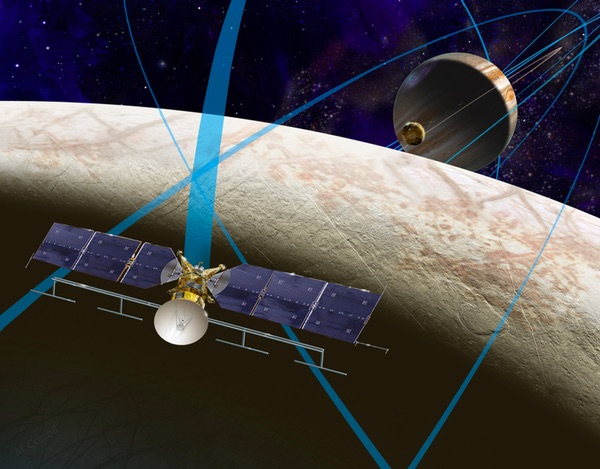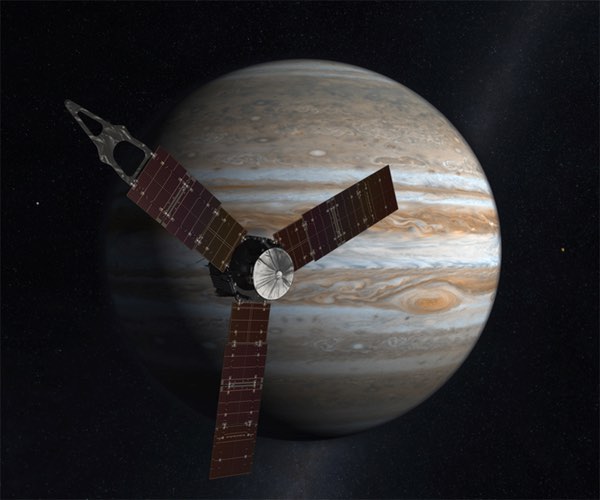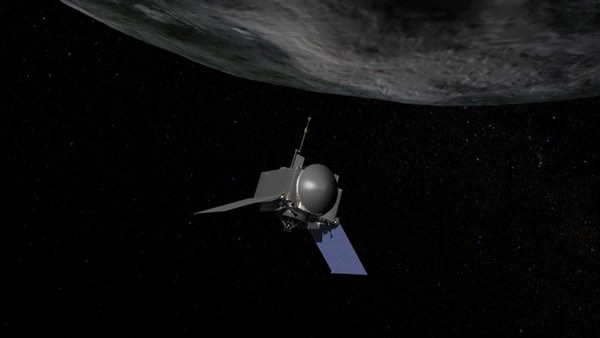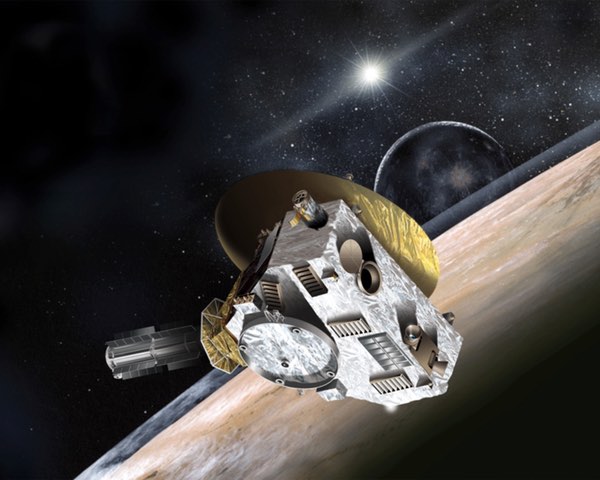New life for New Frontiersby Jason Callahan
|
| NASA plans to issue a call for New Frontiers proposals in late 2016 and, if they follow their past schedule, that means that they’ll make a selection in 2018 for a spacecraft that will probably fly in 2023. |
Small missions tend to fly at more frequently and at a lower cost than large missions, thus presenting more opportunities to early career scientists and engineers, while also providing a greater diversity of destinations. In order to keep the cost and complexity of these missions as low as possible, however, they tend to fly fewer instruments and return far less data.
Large missions supply a great deal of scientific data but usually from a single location. Researchers specializing in the outer planets don’t benefit from a Mars mission, and waiting for a decade (or more) for new data can end a career or cause scientists to move into other fields. Small missions can alleviate this problem somewhat, but their smaller data returns are often inadequate to support more than a few researchers or answer more than basic questions. It’s also very difficult to fly a small mission to the outer planets because the cost of just getting there is greater than most small mission budgets.
Bridging the gap between large and small missions, unsurprisingly, are the medium missions. Medium-sized planetary missions at NASA are flown through the New Frontiers program. These missions fly more frequently than large missions, usually once every five or six years. They have a budget large enough to enable a mission to reach just about anywhere in the solar system, they can carry instruments to answer complex questions about their destinations, and they can provide a career path between small and large missions.
Launched in 2006, the New Horizons spacecraft currently bound for Pluto was the first New Frontiers mission. Second was the Juno spacecraft, launched in 2011 and scheduled to begin orbiting Jupiter next year. The third and most recent, OSIRIS-REx, is currently under construction and scheduled for a 2016 launch. It is designed for extensive in situ study of an organics-rich asteroid and will bring back samples. But until now, NASA had not announced plans for any future New Frontiers missions. That was alarming, because New Frontiers was a hard-won program representing some of the most important aspects of NASA’s planetary efforts.
Selected missions
NASA’s planetary program consists of two types of missions: selected and competed. The most common types of selected missions these days are known as flagships, which are the most comprehensive and expensive science missions flown by NASA. These are the large missions. They cost over a billion dollars each and are strategically selected in a process known as the Planetary Science Decadal Survey. Strategically selected means that the scientific community, rather than NASA, the White House, or Congress, picks the target or the scientific goals (that is, the strategy of the mission). But ultimately the White House has to initiate the project, and Congress has to approve the budget.
The last decadal survey was produced in 2011, and it recommended that NASA develop a Mars rover that can cache samples on the surface of the Red Planet for eventual return to Earth.
| Both Discovery and New Frontiers are in some ways unusual for government programs. They are essentially funding lines in the NASA budget. |
The decadal survey also recommended as its second flagship priority that NASA develop a mission to explore Europa. However, the Europa mission that was presented to the decadal survey committee in 2010 was a monster, a big spacecraft that was far too expensive. Flying that mission would have required a substantial increase to the planetary science budget or severe cutbacks to every other planetary program and project. Considering that the Office of Management and Budget had a very negative perception of flagship missions after the dramatic cost overruns of the James Webb Space Telescope, it was almost inconceivable that such a large mission ever would have received approval.
Fortunately, the decadal survey recommended that NASA find a way to reduce the cost of the Europa mission and the Jet Propulsion Laboratory found a way to make it happen. The Europa Clipper is a much cheaper mission, and due to tremendous popular support (including a long-running campaign by The Planetary Society) and Congressional pressure, the White House finally agreed to fund it.
 A potential Europa Clipper configuration. (credit: NASA/JPL) |
Competed missions
Competed missions at NASA are represented by the Discovery and New Frontiers programs. Both Discovery and New Frontiers are in some ways unusual for government programs. They are essentially funding lines in the NASA budget. This means that Congress and the White House still have to put money into these budget lines in order for missions to fly, but NASA does not have to seek approval for each new mission start.
This arrangement was essentially an agreement by the executive and legislative branches to stay out of micromanaging these planetary science missions: they can decide how much money to put into the funding lines, but they acknowledge that NASA and its advisory groups are best able to select the scientific targets.
So, how are these missions competed? NASA releases an announcement of opportunity, which is a call for mission proposals. Teams of scientists, engineers, and contractors then propose individual missions. These missions can go anywhere in the solar system and have any science goals they want, but usually they try to base them on science priorities established in the decadal survey. The catch is that the missions must remain under a specific cost cap. NASA then evaluates all of the applications and selects the mission with the best planning and most desired science return.
Discovery
The smallest missions in the planetary science program are Discovery class missions that cost around $450 million apiece (not including the launch vehicle). NASA initiated the Discovery program in 1992, and it has produced a long line of successful small missions.
There is a lot of pent-up demand from the planetary science community for these missions, and during the last Discovery call NASA received 28 mission proposals. About a third of them were for asteroid and comet missions, seven were for Venus missions (including four similar radar satellite proposals), and the remainder were for the Moon and Mars, probably with a couple of space-based telescope proposals as well. NASA issued its next call for Discovery proposals in November and will undoubtedly receive a few dozen proposals this round. The strength of Discovery is that it is competitive, and NASA can pick the best mission that will stay within its cost cap.
 Artist’s rendering of Juno at Jupiter. (credit: NASA) |
New Frontiers
NASA created the New Frontiers mission line in 2002 at the recommendation of the decadal survey in order to address high priority and technically complex science goals that were too big for the Discovery program. New Frontiers is a hybrid between a flagship and Discovery. Like Discovery, it is cost-capped at around $1 billion, and is also competed among teams. But like flagships, the target is strategically selected in the decadal survey.
| So what are the New Frontiers missions that will be up for competition in New Frontiers 4? The decadal survey developed a list of five missions. |
The last decadal survey produced a list of seven possible New Frontiers missions, selecting five of them for New Frontiers 4, as the next New Frontier mission is designated, and adding two more to the list for New Frontiers 5. But when the decadal survey committee wrote its report in 2011, it expected New Frontiers 4 to occur within only a few years, in line with the program’s normal rate of mission selection. Budgetary choices by the White House and Congress left NASA’s planetary program with a reduced budget, and no money was allocated for new missions in the New Frontiers program. This year, NASA’s budget request states that the New Frontiers 4 call for proposals will be released by the end of 2016.
Possible New Frontiers missions
So what are the New Frontiers missions that will be up for competition in New Frontiers 4? The decadal survey developed a list of five missions spread around the solar system.
Comet Surface Sample Return
A mission to bring a sample back from the surface of a comet would be probably the most difficult and therefore expensive New Frontiers mission because the ultimate goal is to keep the sample cold all the way back to Earth in order to obtain the best science from it. The last part, getting through the atmosphere with a cold sample, is very difficult. But whoever proposes such a mission will benefit both from the European Space Agency’s experience with Rosetta and its tiny lander Philae as well as the design work already being done for OSIRIS-REx.
Lunar South Pole-Aitken Basin Sample Return
The Moon remains an enigma but also may hold the key to understanding fundamental aspects of our solar system’s formation. A massive impact crater on the lunar far side has punched deep into the surface, making it distinct from the nearside parts of the Moon that have been extensively sampled. A sample returned from the South Pole-Aitken Basin could help determine when the inner solar system was bombarded by asteroids and answer key questions about the formation of the inner planets and possibly even life on Earth. The difficulty of a sampling mission is communications: it would be out of line-of-sight with Earth. This probably requires an orbiting relay satellite, driving up the cost of the mission. But extensive imaging of the surface by NASA’s Lunar Reconnaissance Orbiter has dramatically decreased uncertainty and risk for landing. An all-robotic sample return mission is viable for the next New Frontiers competition. However, one proposal that has been circulating in recent years is for a mission known as Orion-MoonRise that would bring a much larger sample up to a piloted Orion spacecraft. The scientific return from such a mission would be substantial, but it would be extremely difficult to fit a human spaceflight mission into the New Frontiers program as currently configured.
Saturn Probe
This mission would send a probe into Saturn’s atmosphere. Cassini has extensively explored the ringed planet from orbit, and dropped the Huygens spacecraft onto Titan, but Saturn’s complex atmosphere remains an enigma. The mission would not include an orbiter, only a cruise spacecraft that would send the probe straight into the atmosphere without orbiting. Nevertheless, getting a spacecraft all the way to Saturn is expensive, and such a mission might not fit within the New Frontiers cost cap.
Trojan Tour and Rendezvous
The Trojans are a group of more than 6,000 asteroids that share the orbit of Jupiter, settling in two groups, 60 degrees ahead of the planet in its orbit and 60 degrees behind. The Trojans are different from main belt asteroids, in that their compositions are thought to be more like comets than those of the main belt variety (the Trojans might be captured trans-Neptunian objects.) A Trojan mission could benefit from experience with the solar0powered Juno spacecraft, although Juno will spend much of its mission time hibernating, recharging its batteries. Ultimately, a Trojan mission might require a radioisotope thermoelectric generator (RTG) power source.
Venus In Situ Explorer
This would be a mission to sample the Venusian atmosphere and conduct an analysis of the surface. A previous, but unsuccessful, proposal would have used a small circular saw to carve into the surface so that a laser could zap the underlying material. Venus’ hellish operating conditions are the biggest challenge to such a mission.
The decadal survey stressed that there were no relative priorities among those five missions. For New Frontiers 5, two more missions would be added to the list, minus the one selected in NF-4, for a total of six possible missions. These two additional missions would be the Io Observer and the Lunar Geophysical Network.
Io Observer
This mission would send a spacecraft to study the most volcanically active body in the solar system, Jupiter’s moon Io. Io is tugged and squashed by Jupiter and its large moons and as a result it is very hot. Volcanoes and other thermal vents spew sulfur and other materials all over the surface, constantly remaking it. An Io Observer would not enter orbit around the moon but would orbit Jupiter and make repeated flybys, trying to avoid both the incredibly intense radiation and the stuff that Io spews out into space.
Lunar Geophysical Network
During the Apollo program, the astronauts deployed seismic sensors at several points on the Moon’s surface, and these listened for evidence of seismic activity as well as artificially created seismic events like the impact of Apollo hardware. But the Apollo instruments were primitive by today’s standards, the equivalent of a dial-up modem compared to broadband Internet. Equally important, the sensors were all deployed in a relatively small area on the Moon’s near side. If sensors were spread out, with at least one on the lunar farside, it would be possible to use the seismic data to essentially see through the Moon, rather like an ultrasound scan, and create an image of the lunar interior. Doing this would require several landers: at least three and preferably four or five, with at least one on the farside. Multiple landers increases the cost of such a mission. But because many countries are currently interested in lunar exploration, it is possible that NASA could initiate development of an international lunar network involving sensors on landers from countries such as India, Russia and China, assuming that NASA was actually allowed to collaborate with the Chinese space program.
 Artist’s rendering of OSIRIS-REx. (credit: NASA) |
Continued support for New Frontiers
The medium-class missions of the New Frontiers program represent high-priority strategically-selected science goals, prioritized through competition. This summer, New Horizons is going to demonstrate just how impressive that combination can be. But it is not just the scientific excellence of these missions that constitutes the value of New Frontiers to the planetary exploration effort.
| NASA and the White House should be applauded for once again including New Frontiers in the budget request, and the planetary community should continue to support New Frontiers as an essential part of a balanced program of solar system exploration. |
The New Frontiers program, like the Discovery program, provides the planetary science community with a powerful but bureaucratically fragile tool for expanding our knowledge of the solar system. A program with an established budget line is an effective method for reducing the political and bureaucratic vagaries usually required for a new mission start. Creating such a program requires a tremendous amount of effort, and NASA has a long history of planetary programs that flew only a mission or two before they disappeared.
Discovery has more than two decades of success, and the value of the program is essentially undisputed. New Frontiers has already acquired an impressive track record, but the long delay between the call for proposals for New Frontiers 3 in 2009 (leading to the OSIRIS-REx mission) and the New Frontiers 4 announcement of opportunity in 2016 means that the program is vulnerable. NASA and the White House should be applauded for once again including New Frontiers in the budget request, and the planetary community should continue to support New Frontiers as an essential part of a balanced program of solar system exploration.
